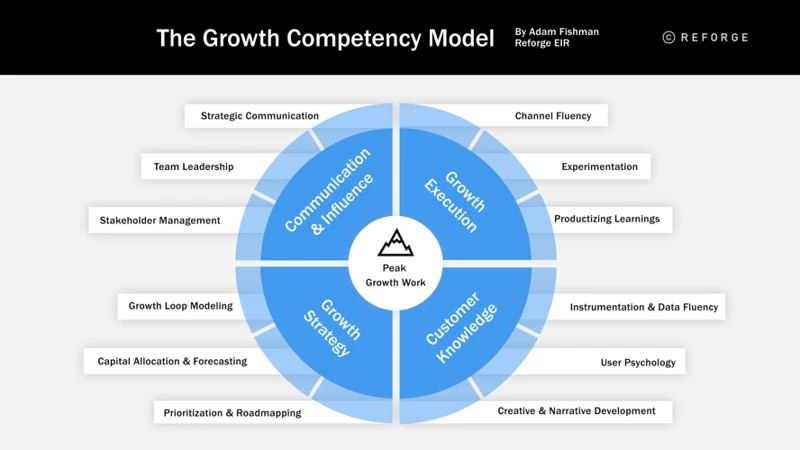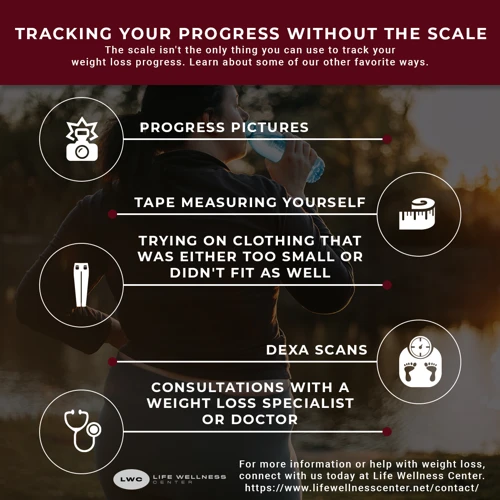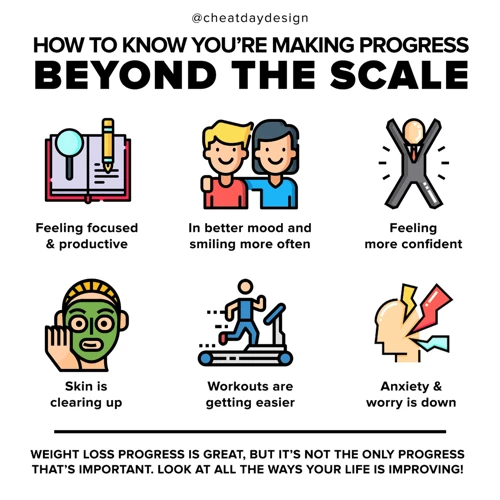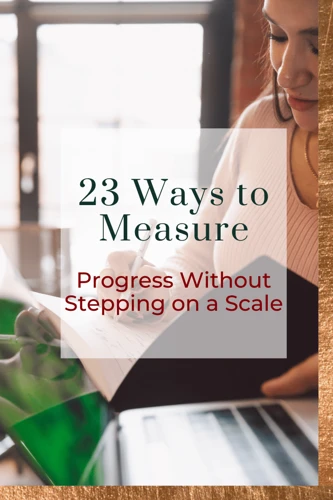Introduction

Entering into a weight loss journey can be a daunting task, and keeping track of progress can be a source of constant frustration for many. While the scale is often the most common indicator of progress, it’s important not to become obsessed with the number on it. In fact, there are numerous other ways to track progress that can actually be more helpful, and less stressful, along the way. In this guide, we’ll explore different methods for tracking progress without solely relying on the scale.
Why Scale Obsession is Unhealthy
Being fixated on the number on the scale can be detrimental to one’s overall health and fitness journey. Here are some reasons why:
- Mental Strain: Constantly obsessing over the scale can lead to stress and anxiety, which can negatively impact mental health.
- No Real Measurement of Progress: The number on the scale can be affected by many factors such as water retention, muscle gain, and hormonal fluctuations. It’s not an accurate representation of one’s progress.
- Unhealthy Habits: Trying to reach a certain number on the scale can lead to unhealthy habits such as skipping meals or excessive exercise. This can actually hinder progress rather than help it.
- Discouragement: If the number on the scale doesn’t show progress, it’s easy to become discouraged and give up on the journey altogether.
- Negative Body Image: Focusing solely on the number on the scale can lead to a negative body image and harmful self-talk.
It’s important to realize that the number on the scale doesn’t define one’s progress or overall health. By focusing on other aspects of health and fitness, such as body measurements, photos, and energy levels, a more accurate representation of progress can be achieved.
Body Measurements

Keeping track of your progress on a weight loss or fitness journey can often seem daunting. However, relying solely on the scale can lead to unhealthy obsession and discouragement. That’s where body measurements come in as an important tool to track progress in a more accurate and reliable manner. Tracking your body measurements provides a comprehensive picture of the changes happening in your body, including muscle gain and fat loss. In this section, we’ll explore the importance of body measurements, and provide tips on how to take accurate measurements for optimal progress tracking.
Importance of Body Measurements
Taking body measurements is an essential part of tracking your progress without obsessing over the scale. The scale can be misleading as it doesn’t take into account the changes in body composition. For example, if you’ve been working out and building muscle, you may not see a decrease in weight on the scale, but your body measurements could have changed.
By taking body measurements, you can track changes in your body and see where you are losing inches. This can be a great motivator to keep going, especially if you aren’t seeing the scale move much.
Taking body measurements can help you identify problem areas that you may need to focus on. For example, if you are losing inches in most areas but not in your waist, it may be time to re-evaluate your diet and exercise routine.
Tracking body measurements also allows you to see progress over time. You may not notice small changes day to day, but by tracking your measurements over weeks and months, you can see just how far you’ve come.
Taking body measurements is important for accurate tracking of progress and can help keep you motivated on your fitness journey.
How to Take Accurate Measurements
Taking accurate body measurements is crucial for tracking progress without obsessing over the scale. Follow these steps to ensure you get accurate measurements every time:
- Use a cloth tape measure: It’s essential to use a cloth tape measure, which provides more accurate measurements than a metal one. You can find a cloth tape measure at your local store or online.
- Measure at the same time of day: To reduce variability, it’s best to measure at the same time of day. Usually, the morning is the best time to take these measurements.
- Don’t measure over clothing: For accurate measurements, wear tight-fitting clothing or nothing at all. Never measure over thick clothing, as this will cause inaccurate measurements.
- Measure at the right places: You need to measure yourself in specific areas to get accurate progress tracking. The most common areas to measure are the waist, hips, chest, arms, and thighs. You can also measure your neck or calves, depending on your preferences. To ensure that you are measuring the right area, use a mirror or have someone help you.
- Record your measurements: Keep a record of your measurements, and measure yourself every two to four weeks. This way, you can track your progress over time accurately.
By following these steps, you can take accurate body measurements, which will help track your progress without worrying about the number on the scale.
Photos

Documenting your progress through photos can be a highly effective and insightful way to track your fitness journey. Photos can capture changes and progress over time that may not be noticeable on the scale or even through measurements alone. By taking regular photos and analyzing them closely, you can gain a deeper understanding of your body and the changes that are occurring. However, it’s important to know how to take these photos effectively to ensure that you are accurately capturing your progress. In this section, we’ll explore the importance of progress photos, and provide tips on how to take them.
Why Photos Help
Using progress photos can be a very helpful tool for tracking your progress without obsessing over the scale. Photos provide a visual representation of how our bodies are changing over time, and can be a great way to see changes that may not be as visible day to day. They can also serve as a source of motivation and encouragement as we see ourselves making progress towards our goals.
Taking progress photos may initially feel uncomfortable or intimidating, but it’s important to remember that this is a tool for ourselves and not for anyone else’s judgment or comparison. When taking the photos, it’s important to wear form-fitting clothing and stand in a consistent position and lighting to accurately compare changes over time.
Here’s an example of a table that can be used to track progress photos:
| Date | Front View | Side View | Back View |
|---|---|---|---|
| Week 1 | Insert Photo | Insert Photo | Insert Photo |
| Week 4 | Insert Photo | Insert Photo | Insert Photo |
| Week 8 | Insert Photo | Insert Photo | Insert Photo |
Remember, progress photos should be just one of many tools used to track progress. While they can be helpful, it’s important to remember that bodies come in all shapes and sizes, and progress looks different on everyone. Use photos as a complimentary tool to other methods such as body measurements, clothes fit, and energy levels.
How to Take Progress Photos
If you want to track your progress without relying solely on the scale, progress photos can be a great tool. Here are some tips for taking progress photos effectively:
- Pick a consistent time and day: It’s best to take progress photos at the same time and day each week, as this will give you the most accurate picture of how your body is changing.
- Wear the same clothes: Wearing the same clothing in each photo can help you see how the fit of the clothes is changing over time. You may want to wear form-fitting athletic wear or a swimsuit for consistency.
- Use consistent lighting: Consistent lighting can help you see small changes in your body over time. Choose a spot with good lighting and try to take photos at the same time of day to keep lighting consistent.
- Take photos from different angles: Taking photos from the front, back, and side can help you see changes in your body shape and posture.
- Don’t focus on perfection: Remember that the goal of progress photos is to track your progress, not to achieve perfection. Try to celebrate your progress, no matter how small.
By using these tips, you can take progress photos that accurately and effectively track your fitness journey without relying on the scale.
Clothes and How They Fit

As much as we try to avoid it, our weight can fluctuate day-to-day, leading to frustration and even obsession over the number on the scale. That’s where tracking progress without solely relying on the scale comes in handy. One of the ways to do this is by paying attention to how your clothes fit. This can seem like a daunting task, but in reality, it’s a great way to see the changes in your body composition without being fixated on a specific number. Let’s explore the significance of clothes fit in tracking progress towards your health and fitness goals.
Importance of Clothes Fit
A vital element of progress tracking that is often overlooked is the importance of clothes fit. Wearing clothing that fits properly can improve your confidence and self-esteem, which are essential elements of maintaining long-term weight loss. Poorly fitting clothes can have the opposite effect and hinder your progress by making you feel discouraged and self-conscious.
Having clothes that fit well can also give you a more accurate representation of your body’s changes. As you lose weight and build muscle, your body shape and size may change, even if the number on the scale stays the same. Being able to fit into clothes that were previously too tight is a tangible sign of progress that can motivate you to keep going.
Furthermore, clothing fit can provide valuable insight into which areas of your body you are losing inches from. You may notice that your pants are looser around the waistline or that your shirt fits more loosely around the arms and chest. This information can help you tailor your workouts to target specific areas and achieve the results you desire.
It’s important to keep in mind that not all clothing fits the same way, even within the same brand. It’s a good idea to try on a variety of clothing items to get a more accurate idea of your progress. Don’t be afraid to invest in a few key wardrobe pieces that you can use to gauge your progress over time.
In summary, paying attention to how your clothes fit is an essential component of tracking progress without obsessing over the scale. It can boost your confidence, provide insight into which areas of your body are changing, and serve as a tangible sign of progress. So, make sure to incorporate this method into your progress-tracking routine.
How to Evaluate Clothes Fit
Evaluating how clothes fit can be a great way to track progress without obsessing over the scale. Here are some ways to evaluate clothes fit:
| Step | Description |
|---|---|
| Step 1: | Try on clothes that you haven’t worn in a while. |
| Step 2: | Take note of how they fit compared to when you last wore them. |
| Step 3: | Check for any changes in how the fabric feels against your skin. |
| Step 4: | Look for any noticeable differences in the way your clothes hang or drape on your body. |
| Step 5: | Pay attention to whether certain areas (such as the waist or hips) feel tighter or looser. |
It’s important to remember that even small changes in how clothes fit can indicate progress, and should be celebrated as such. Don’t be discouraged if you don’t notice any changes right away. Stick with your healthy habits, and over time you’re likely to see results not just on the scale, but in the way your clothes fit, too.
Energy Levels and Cravings

Are you tired of fixating on the number on the scale? There are plenty of other ways to track your health and fitness progress that don’t involve obsessing over weight. One important aspect to consider is your energy levels and cravings. These two factors can provide insight into how your body is responding to your lifestyle habits, without solely relying on the scale. But how exactly can you track and evaluate these aspects of your health journey? Let’s explore some helpful tips and strategies.
Importance of Energy Levels and Cravings
Having stable and high levels of energy is crucial for both physical and mental well-being. Proper nutrition and exercise play a major role in maintaining healthy energy levels. With energy levels as a guide, a person can identify what foods or types of workouts may be more beneficial to their bodies.
Cravings can provide indications of how the body is responding to certain types of nutrition. They can occur for a variety of reasons, including hormonal imbalances, emotional distress, or dehydration. Addressing the root cause of cravings can lead to better health. Tracking them can be especially valuable when making dietary changes.
Keeping track of energy levels and cravings is also useful for identifying changes in behavior or emotional states. If fatigue or emotional distress leads to unhealthy habits such as comfort eating, it can be important to address those underlying issues. Observing and recording patterns can help a person develop new, healthier habits to replace the negative ones.
In addition to physical health, energy levels and cravings can also affect a person’s mental health. After eating a heavy or unhealthy meal, many people report feeling sluggish or even irritable. On the other hand, eating well and staying active can lead to feelings of accomplishment and positivity. By tracking their energy and cravings, individuals can gain a better sense of how their choices are impacting their mood and overall well-being.
By tracking these factors, individuals can gain valuable insights into their own health and make more informed decisions about how to maintain a healthy lifestyle. It’s essential to remember that progress isn’t always linear, and that fluctuations in energy and cravings are normal. By noticing and addressing changes as they occur, individuals can continue building healthy habits for a lifetime.
- Regularly tracking energy levels and cravings can help identify food and workout preferences, deficiencies and other issues that affect well-being.
- Cravings can arise due to dehydration, emotional distress and hormonal imbalances among other factors. Identifying their root causes can help make more informed decisions on diet and workouts.
- Tracking and identifying patterns of cravings and energy levels is useful when addressing behavioral or emotional issues that lead to unhealthy habits.
- Energy levels, cravings and mood have a close relationship. Good nutrition and exercise can provide feelings of positivity and accomplishment whilst poor diet can make one feel sluggish and irritable or anxious.
- It’s important to remember that progress isn’t linear and that changes in energy and cravings are normal. Tracking can help address issues and develop new, healthy habits for sustainable health.
How to Evaluate Energy and Cravings
Evaluating your energy levels and cravings can be helpful in tracking your progress without obsessing over the scale. Here are some ways to do this:
Method | Explanation
———— | ————-
Keep a food and mood journal | Write down what you eat and how you feel after eating it. This can help you identify patterns between what you eat and how it affects your energy levels and cravings.
Pay attention to hunger cues | Take note of when you start to feel hungry and when you feel full. This will help you become more in tune with your body’s needs and avoid overeating, which can lead to energy crashes and increased cravings later on.
Track your water intake | Dehydration can cause feelings of fatigue and make it harder to resist cravings. Make sure you are drinking enough water throughout the day to stay hydrated.
Record your exercise routine | Exercise can have a big impact on your energy levels and cravings. Keep track of your workouts and how they make you feel. Do you have more energy on days that you exercise? Do you experience fewer cravings afterwards?
Listen to your body | Ultimately, the best way to evaluate your energy levels and cravings is to pay attention to your body. If you feel tired or sluggish, take a break and rest. If you are craving something sweet or salty, try to find a healthy alternative or allow yourself a small indulgence. Trusting your instincts can be a powerful tool in achieving your health goals.
By evaluating your energy levels and cravings in these ways, you can gain a better understanding of how your body works and how to make choices that will support your overall health and wellbeing.
Tracking Food and Exercise
![]()
When it comes to reaching fitness goals, tracking food intake and exercise progress is crucial. However, it’s important to track in a healthy way that doesn’t lead to obsession over numbers. By finding a balanced approach to tracking, you can stay motivated and aware of your progress without getting bogged down in the details. Here are some strategies for tracking food and exercise that take into account the bigger picture of overall health and well-being.
How to Track Food Intake
Tracking food intake can be a powerful tool in reaching your health and fitness goals. It allows you to see exactly what you’re consuming and make informed decisions about your diet. Here are some ways you can track your food intake:
| Method | Description |
|---|---|
| Food Diary | Write down everything you eat and drink throughout the day in a notebook or app. Be sure to include portion sizes and any condiments or dressings used. |
| Meal Plan | Create a meal plan for the week that includes all the foods you’ll be eating. This can help you stay on track and avoid making impulsive food choices. |
| Macro Tracking | Calculate your daily macronutrient needs and track your intake of protein, carbohydrates, and fat. This can help ensure you’re getting the right balance of nutrients for your body. |
| Food Logging App | Download an app that allows you to input your meals and snacks. Many apps will also provide you with nutritional information about the foods you’re consuming. |
Keep in mind that tracking your food intake shouldn’t become an obsessive or stressful activity. It’s important to approach it with a balanced and practical mindset, and to remember that small changes over time can lead to significant progress.
How to Track Exercise Progress
Tracking exercise progress is an important aspect of achieving fitness goals. Here are some effective ways to track your exercise progress:
- Keep a workout log: Record the exercises you do, the weight and number of sets and reps. This can help you see if you are increasing the weight or reps over time.
- Use a fitness tracker: A fitness tracker can help you keep track of your heart rate, calories burned, and distance covered during a workout.
- Measure your endurance: Keep track of how long it takes you to run a mile, how many push-ups or sit-ups you can do. Track these times or numbers over time to see improvements.
- Try new exercises: If you notice that you’re not making progress, try something new. It could be a new exercise or a different method of weight training.
- Set goals: Setting goals is a great way to stay motivated. Aim for a specific number of workouts per week or a certain amount of weight loss per month.
Remember that exercise progress can be measured in many ways, not just the number on the scale. By tracking your progress in these ways, you can stay motivated and focused on your goals.
Non-Scale Victories

As tempting as it can be to track progress solely through the number on the scale, it’s important to remember that weight is not the only indicator of progress. The journey to a healthier lifestyle is not just about losing pounds, but also about making positive changes in your overall health and wellbeing. That’s where non-scale victories come in. These victories, no matter how small, can provide a much-needed boost of motivation and help reinforce healthy habits. Let’s explore why non-scale victories matter and how you can incorporate them into your progress tracking.
Why Non-Scale Victories Matter
Non-scale victories are an essential part of tracking your progress because they offer a more comprehensive view of your overall health and well-being. Focusing solely on the numbers on the scale can be discouraging, especially when progress seems slow or non-existent. However, celebrating non-scale victories reinforces positive behaviors and encourages further progress.
Non-scale victories matter because:
| 1. | They help you focus on the positive changes you have made. |
| 2. | They provide motivation to continue working towards your goals. |
| 3. | They boost your confidence and self-esteem. |
| 4. | They can inspire others to make positive changes in their own lives. |
Non-scale victories can come in many forms, such as fitting into a smaller clothing size, having more energy throughout the day, or being able to lift heavier weights. These achievements should be celebrated and recognized as tangible evidence of progress, rather than solely relying on the number on the scale.
By prioritizing non-scale victories, you shift the focus from just weight loss to overall health and wellness. This can lead to sustainable lifestyle changes that improve both physical and mental health in the long run. Remember to acknowledge and celebrate non-scale victories as much as you would celebrate reaching a certain number on the scale.
Examples of Non-Scale Victories
Achieving non-scale victories can be even more fulfilling than seeing a smaller number on the scale. These victories can be personal achievements that demonstrate progress in various areas of your life. Here are some examples of non-scale victories that you can celebrate:
- Increased endurance: Being able to do more cardio or lift heavier weights without getting as tired or out of breath.
- Better sleep: Improving your sleeping habits by including more hours of rest per night, without feeling tired after waking up.
- Inches lost: Noticing a difference in body circumference measurements, even if the scale isn’t moving much.
- Improved flexibility: Being able to touch your toes or perform more difficult yoga poses.
- Improved skin: Clearer and more radiant skin thanks to a healthier diet and increased water intake.
- Better mood: Feeling happier, more confident, and having greater self-esteem thanks to the positive changes you’re making in your lifestyle.
- Reduced cravings: Being able to resist unhealthy food options and choosing healthier alternatives instead.
- Increased productivity: Being able to complete tasks faster and with more energy, thanks to a healthier mind and body.
- Lower stress levels: Feeling less stressed and more relaxed due to incorporating stress-reducing activities like meditation and yoga into your routine.
- Improved mental and emotional health: Feeling more positive, confident, and aware of your emotions, leading to a better state of mental and emotional health overall.
Remember, there are many ways to measure progress beyond the scale. Celebrate your non-scale victories, no matter how small they may seem, and keep working towards your goals.
Mental and Emotional Health
As important as it is to track your physical progress, it is equally crucial to monitor and nurture your mental and emotional health. Focusing solely on numbers and the scale can lead to a negative mindset and obsessive behavior. It’s essential to remember that health and wellness encompass more than just physical attributes. In this section, we will explore strategies to promote mental and emotional well-being on your fitness journey.
Importance of Mental and Emotional Health
Maintaining a healthy mental and emotional state is crucial when embarking on a weight loss journey. Psychological wellbeing has a profound effect on physical health, and vice versa. Studies have shown that stress and anxiety can lead to weight gain, while depression can cause weight loss. It is essential to prioritize mental and emotional health when trying to improve physical health.
Some ways to maintain good mental and emotional health during a weight loss journey include:
- Meditation and mindfulness: These can help with stress management and improve overall emotional wellbeing. Try incorporating a short meditation or mindfulness session into your daily routine.
- Talking to a therapist or support group: Having someone to talk to can help you process emotions, manage stress and anxiety, and stay motivated through tough times. Seeking professional help is nothing to be ashamed of and can be incredibly beneficial.
- Taking breaks and practicing self-care: It’s important to take time for yourself and engage in activities that bring you joy and calmness. Whether it’s taking a relaxing bath, reading a book, or going for a walk, self-care is essential for maintaining good mental and emotional health.
- Being kind to yourself: It’s easy to be hard on ourselves, especially when trying to achieve a specific weight or fitness goal. However, focusing on small, achievable goals and celebrating progress, no matter how small, can help you maintain a positive mindset and stay motivated.
Prioritizing mental and emotional health on a weight loss journey is vital for overall wellbeing. Incorporating practices such as meditation, therapy or support groups, self-care, and self-compassion can help promote a positive and healthy mindset.
Strategies to Promote Mental and Emotional Health
Promoting mental and emotional health is an essential aspect of tracking your progress without obsessing over the scale. Here are some strategies to help you maintain a healthy mindset:
- Prioritize Self-Care: Make sure to take time out of your day to practice self-care activities that energize and rejuvenate you. This could include activities such as taking a relaxing bath, meditating, or journaling.
- Practice Mindfulness: Mindfulness practice involves staying in the present moment and focusing on your thoughts, emotions, and sensations. This can help you better manage stress and anxiety related to weight loss journeys.
- Ask for Support: Don’t be afraid to reach out to loved ones, a therapist, or a support group to help you during your journey. Supportive people can help you stay motivated, provide encouragement and offer a listening ear when needed.
- Set Realistic Goals: Setting realistic goals can help you avoid frustration and disappointment. Try setting small, achievable goals that are easy to reach, so that you can see your progress more frequently.
- Focus on the Positives: Remember to celebrate your achievements, no matter how small. It’s easy to become caught up in negative self-talk when we don’t see the results we want. However, it’s important to recognize and celebrate the positive changes we make in our lives.
- Identify Triggers: Identifying the factors that trigger negative emotions related to weight loss can help you better manage them. For example, if seeing certain types of food triggers feelings of guilt, try to avoid them or practice moderation.
- Prioritize Sleep: Getting enough sleep is essential for our mental and physical health. Aim for at least 7-8 hours of sleep a night to ensure that you feel rested and energized.
Using these strategies to promote mental and emotional well-being can help you maintain a positive attitude and stay motivated, even when the scale doesn’t budge. Remember, weight loss is not just about physical changes, but also about creating healthy habits and a healthy mindset.
Conclusion
In conclusion, it’s important to remember that obsessing over the scale is not a healthy way to track progress on your fitness journey. Instead, consider incorporating various methods to evaluate your progress, such as body measurements, progress photos, clothes fit, energy levels, food and exercise tracking, non-scale victories, and mental and emotional health.
By using these alternative methods, you can track your progress without fixating on a number on a scale. Remember, weight can fluctuate due to various factors, and it’s not always an accurate reflection of your overall health and fitness.
Take the time to celebrate your progress, both big and small, instead of solely focusing on reaching a specific number on the scale. Celebrating non-scale victories and prioritizing mental and emotional health can also contribute to a more positive and sustainable approach to health and fitness.
So, keep in mind that progress comes in many forms, and don’t let the scale dictate your self-worth or satisfaction with your progress. Trust the process, stay consistent, and remember to celebrate your achievements along the way.
Frequently Asked Questions
What if I can’t see progress in my photos?
Don’t get discouraged! Progress takes time and may not always be visible in photos. Try looking for other signs of progress such as changes in measurements or clothes fit.
How often should I take progress photos?
It’s up to personal preference, but once a month should suffice to capture noticeable changes.
Can clothes fit be an accurate way to track progress?
Yes, because as you lose fat and gain muscle, your clothes will fit differently. Pay attention to how clothes fit in certain areas such as the waist, hips, and legs.
Why is tracking food intake important?
Tracking food intake helps you become more aware of what you’re eating and how much. This can lead to making healthier choices and staying on track with your goals.
How can I track food intake without obsessing over calories?
Focus on the quality of the food you’re eating rather than counting calories. Choose whole, nutrient-dense foods and pay attention to portion sizes.
Why is mental and emotional health important in weight loss?
Weight loss is not just about physical health, but mental and emotional health as well. It’s important to have a positive relationship with food and your body in order to achieve long-term success.
How can I track exercise progress without a gym membership?
There are many ways to exercise at home such as bodyweight exercises, yoga videos, or using resistance bands. Set goals to improve the number of reps or weights used in these exercises.
What if my energy levels and cravings don’t improve?
Consult with a healthcare professional to rule out any underlying health issues. It may also be helpful to experiment with different foods and exercise routines to find what works best for your body.
What are some non-scale victories for weight loss?
Non-scale victories can include improved sleep, increased strength and endurance, improved mood, and better overall health markers such as blood pressure and cholesterol levels.
How can I promote mental and emotional health during weight loss?
Practice self-care, set realistic goals, and focus on progress rather than perfection. Surround yourself with a supportive community and seek professional help if needed.







